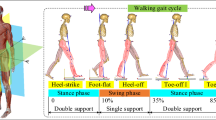Abstract
To promote the rehabilitation training occupied at home, in this article, a wheelchair-exoskeleton system combining the lower extremity exoskeleton (LEE) and the mobile wheelchair is developed to help users to complete the activities of daily life. A hierarchical control architecture is designed and developed for the wheelchair-exoskeleton system. The control architecture is composed of three layers: (1) the top layer is achieved by the task-based voice-controlled strategy through voice recognition; (2) the decision layer produces the intent actions based on the output of the top layer; (3) the execution layer is in charge of controlling the movement of the system, including the gait tracking control of LEE as well as the coordination control of the mobile wheelchair. The mobile wheelchair as a partner works in coordination with the LEE by positioning techniques through utilizing ultra-wideband (UWB) sensors. A small validation study with three able-bodied subjects performing the whole usage process is presented. The experimental results demonstrate that the developed wheelchair-exoskeleton system has the potential to be applied to in-home care with long endurance.
Similar content being viewed by others
Data Availability
Not applicable.
Code Availability
Not applicable.
References
Chen, B., Ma, H., Qin, L.Y., et al.: Recent developments and challenges of lower extremity exoskeletons. J. Orthop. Translat. 5, 26–37 (2016). https://doi.org/10.1016/j.jot.2015.09.007
Díaz, I., Gil, J.J., Sánchez, E., Lower-limb robotic rehabilitation: literature review and challenges. J. Robot. 2011, 1-11 (2011). https://doi.org/10.1155/2011/759764
Kwon, S.H., Lee, B.S., Lee, H.J., Kim, E.J., et al.: Energy efficiency and patient satisfaction of gait with knee-ankle-foot orthosis and robot (ReWalk)-assisted gait in patients with spinal cord injury. Ann. Rehabil. Med. 44, 131–141 (2020). https://doi.org/10.5535/arm.2020.44.2.131
Wang, S.Q., Wang, L.T., Meijneke, C., et al.: Design and Control of the MINDWALKER Exoskeleton. IEEE Trans. Neural Syst. Rehabil. Eng. 23(2), 277–286 (2015). https://doi.org/10.1109/TNSRE.2014.2365697
Kolakowsky-Hayner, S.A., Crew, J., Moran, S., Shah, A.: Safety and feasibility of using the EksoTM bionic exoskeleton to aid ambulation after spinal cord injury. J. Spine 4(3), 1–8 (2013). https://doi.org/10.4172/2165-7939.S4-003
Juszczak, M., Gallo, E., Bushnik, T.: Examining the effects of a powered exoskeleton on quality of life and secondary impairments in people living with spinal cord injury. Top. Spinal Cord Inj. Rehab. 24(3), 336–342 (2018). https://doi.org/10.1310/sci17-00055
Song, Z., Tian, C., Dai, J.S.: Mechanism design and analysis of a proposed wheelchair-exoskeleton hybrid robot for assisting human movement. Mech. Sci. 10, 11–24 (2019). https://doi.org/10.5194/ms-10-11-2019
Borisoff, J.F., Mattie, J., Rafer, V.: Concept proposal for a detachable exoskeleton-wheelchair to improve mobility and health. In: Proc. IEEE International Conference on Rehabilitation Robotics (ICORR), University of Washington, Seattle, WA (2013). https://doi.org/10.1109/ICORR.2013.6650396
Shankar, T., Santosh, K.D.: A Hybrid Assistive Wheelchair- Exoskeleton. In: Proc. International Convention on Rehabilitation Engineering & Assistive Technology, Singapore Therapeutic, Assistive & Rehabilitative Technologies Centre (2015)
Kim, D., Kang, B.B., Kim, K.B., et al.: Eyes are faster than hands: A soft wearable robot learns user intention from the egocentric view. Sci. Robot. 4, essay 2949 (2019). https://doi.org/10.1126/scirobotics.aav2949
Vouga, T., Zhuang, K.Z., Olivier, J., et al.: EXiO—A brain-controlled lower limb exoskeleton for rhesus macaques. IEEE Trans. Neural Syst. Rehabil. Eng. 25(2), 131–141 (2017). https://doi.org/10.1109/TNSRE.2017.2659654
Leonardo, C., Meyer, J.T., Galloway, K.C., et al.: Assisting hand function after spinal cord injury with a fabric-based soft robotic glove. J. Neuroeng. Rehabil. 15(1), 59 (2018). https://doi.org/10.1186/s12984-018-0391-x
Anam, K., A-Jumaily, A.A.: Active exoskeleton control systems: state of the art. Procedia Eng. 41, 988–994 (2012). https://doi.org/10.1016/j.proeng.2012.07.273
Long, Y., Du, Z.J., Cong, L., et al.: Active disturbance rejection control based human gait tracking for lower extremity rehabilitation exoskeleton. ISA Trans. 67, 389–397 (2017). https://doi.org/10.1016/j.isatra.2017.01.006
Zhao, S., Huang, B., Liu, F.: Localization of indoor mobile robot using minimum variance unbiased FIR filter. IEEE Trans. Autom. Sci. Eng. 15, 410–419 (2018). https://doi.org/10.1109/TASE.2016.2599864
Duan, S., Su, R., Xu, C., et al.: Ultra-wideband radio channel characteristics for near-ground swarm robots communication. IEEE Trans. Wirel. Commun. 99, 1–10 (2020). https://doi.org/10.1109/TWC.2020.2986446
Long, Y., Du, Z.J., Chen, C.F., et al.: Development and analysis of an electrically actuated lower extremity assistive exoskeleton. J. Bionic Eng. 14(2), 272–283 (2017). https://doi.org/10.1016/S1672-6529(16)60397-9
Long, Y., Du, Z.J., Wang, W.D., Dong, W.: Human motion intent learning based adaptive motion assistance control for a wearable exoskeleton. Robot. Comput. Integr. Manuf. 49, 317–327 (2018). https://doi.org/10.1016/j.rcim.2017.08.007
Long, Y., Du, Z.J., Wang, W.D., Dong, W.: Development of a wearable exoskeleton rehabilitation system based on hybrid control mode. Int. J. Adv. Rob. Syst. 13(5), 1–13 (2016). https://doi.org/10.1177/1729881416664847
Noronha, B., Dziemian, S., Zito, G.A., Faisal, C. Konnaris, and A.A.: Wink to grasp comparing eye, voice & emg gesture control of grasp with soft robotic gloves. In: Proc. Int. Conf. Rehabil. Robot., pp. 1043–1048 (2017)
Tran, P., Jeong, S., Wolf, S.L., Desai, J.P.: Patient-specific, voice-controlled, robotic FLEXo tendon Glove-II system for spinal cord injury. IEEE Robot. Autom. Lett. 5(2) (2020)
Funding
This work was supported by the Fundamental Research Funds for the Central Universities (N2129002) and Natural Science Foundation of Guangdong Province (2020A1515110121).
Author information
Authors and Affiliations
Contributions
Yi Long conceived and designed the study. Yajun Peng performed the experiments. Yi Long written, reviewed and edited the manuscript. All authors read and approved the manuscript.
Corresponding author
Ethics declarations
Conflicts of Interest/Competing Interests
The authors declare that they have no conflicts of interest.
Ethical Approval
The experiments are performed in the laboratory and ethical approval is granted by the Laboratory Management Council.
Consent to Participate
Not applicable.
Consent to Publish
Not applicable.
Additional information
Publisher’s Note
Springer Nature remains neutral with regard to jurisdictional claims in published maps and institutional affiliations.
Appendix
Appendix

Notation: a, b, d, kl and kr are predefined positive parameters, Wl and Wr are the control variables for the left wheel and the right wheel respectively. The other action, e.g., “wheelchair come”, does not judge whether the L3 is bigger or smaller than the defined distance d.
Rights and permissions
About this article
Cite this article
Long, Y., Peng, Y. Development and Validation of a Robotic System Combining Mobile Wheelchair and Lower Extremity Exoskeleton. J Intell Robot Syst 104, 5 (2022). https://doi.org/10.1007/s10846-021-01550-8
Received:
Accepted:
Published:
DOI: https://doi.org/10.1007/s10846-021-01550-8




